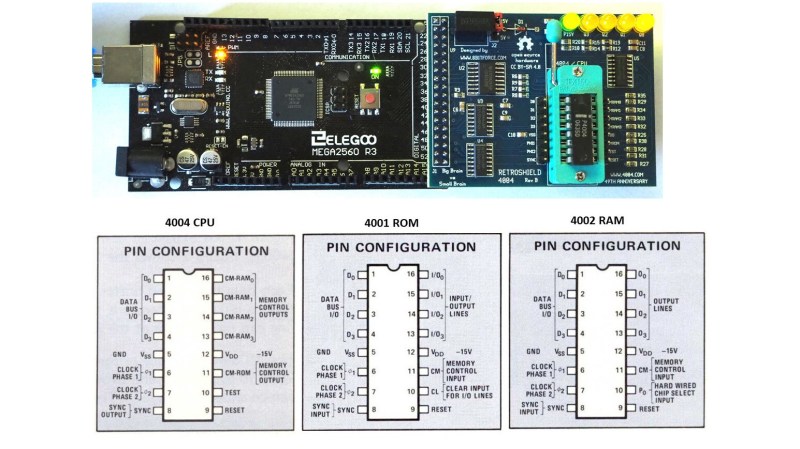This weekend marked the 49th anniversary of the legendary Intel 4004 microprocessor, and to celebrate [Erturk Kocalar] combined the old and new in this intriguing Retroshield 4004 / Busicom 141-PF calculator project. We have reported on his Arduino shield project before, which lets you connect a variety of old microprocessors to an Arduino so you can experiment with these old chips with a minimum of fuss.
[Erturk] decided to use the Arduino to simulate the hardware of the Busicom 141-PF, a calculator famous for bringing us the microprocessor. In addition to the calculator, the Arduino has to simulate the Intel 4004 CPU’s supporting chips, which include ROM, RAM, and shift registers. If you want to build one of these yourself, all the design files are open source, or you can get an assembled shield from his Tindie store. In either case, you will have to provide your own 4004, which are surprisingly still available. (Tindie and Hackaday share the same parent company, Supplyframe. We’ve got nothing to do with Intel.)
We really appreciate the detailed explanation that [Erturk] provides about the inner workings of the calculator. Interfacing the emulator to the original ROM code running on the 4004 is non-trivial — take a look at the explanation of the spinning drum printer, for example. We enjoyed perusing the annotated ROM listing, as well as reading the story of the efforts which have been undertaken to prevent these historical documents from being lost forever. Be sure to check out the history of the 4004 and its inventor Federico Faggin if you’d like to delve deeper.
















“as well as reading the story of the efforts which have been undertaken to prevent these historical documents from being lost forever.”
Tell me about it!
A couple of weeks ago the company I work for threw out 4 (vacuum packed) reels (qty. 1800) of a Freescale device (40 pin?).
I called up NXP with the part number, (as I couldn’t find it on the NXP, or any reseller website).
They told me that they don’t keep any documentation of EOL products.
Gee, I guess if someone really needed to know what that chip was doing in their equipment, they’re SOL!
theoretically EOL products can be licensed to another company that takes over inventory and support. It doesn’t happen for every chip, mainly the ones with the kind of customer base where you can charge $45 for a 10 cent part and they’re happy to pay. (I know that I would rather repair a control board in some factory automation machinery than replace everything, even if the repair costs low 5 figures)
Did you try the part number at?:
https://octopart.com/
Thanks,
I just tried it. Not there.
The part was Freescale SC426311CFN
(the dumpster has since been emptied).
Mega2650 is nice as there’s just enough room on most protoshields to use a 40pin device and still have space for some supporting logic. I’ve used it to make an ay-4-8910 chiptune player. Also it’s 5V so it works well with vintage stuff.